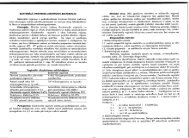PHYSICS
n - susliks.lv
n - susliks.lv
- No tags were found...
Create successful ePaper yourself
Turn your PDF publications into a flip-book with our unique Google optimized e-Paper software.
(fig. 22.7, a). The furthest distance from the eye that an object<br />
can be brought into focus on the retina is called the far point<br />
(fig. 22.7, b). In order to focus parallel light on the retina, a<br />
diverging lens (spectacles) is used which forms a virtual image at<br />
the far point of the eye. The corneal-lens system can now focus<br />
light on the retina (fig. 22.7, c).<br />
164<br />
~ Fa:..point :::11t=<br />
~ 100cm<br />
a<br />
"""::~::::ITt§<br />
c<br />
Fig. 22.7. The short-sighted eye: a - the light from a distant object is<br />
brought to a focus in front of the retina; b the far point - the<br />
farthest distance from the eye that an object can be brought to a focus<br />
on the retina; c - diverging spectacles can focus light on the retina<br />
Long-sight (Hypermetropia). A long-sighted person can see<br />
distant objects distinctly, but not those that are close. With the<br />
latter, objects are focused behind the retina due to the eyeball<br />
being too short (fig. 22.8, a). An object at the near point,<br />
however, can be seen clearly (fig. 22.8, b). A converging lens<br />
(spectacles) is used when viewing closer objects. It forms a virtual<br />
image at the near point (fig. 22.8, c).<br />
Astigmatism occurs as a result of a lack of symmetry in the<br />
cornea. When a pattern such as that in fig. 22.9 is viewed, one set<br />
of lines appears sharper than the others. The defect can be<br />
corrected by cylindrical lenses.<br />
Spherical Aberration is found on all lenses bound by spherical<br />
surfaces. The marginal portions of the lens bring rays into a<br />
shorter focus than the central region (fig. 22.10), making the<br />
image of a point a small blurred circle.<br />
Chromatic Aberration. All lenses made of a single material<br />
refract rays of shorter wavelengths more strongly than those of<br />
longer wavelengths and in doing so bring blue light to a shorter<br />
b<br />
§<br />
~~<br />
.... =::::- ..<br />
0.25 m >---I<br />
0.6 m ~ -----<<br />
Fig. 22.8.The long-sighted eye: a - the light from a near object is<br />
focused behind the eye; b the near point - the distance from the<br />
eye that an object can be clearly seen; c - converging spectacles can<br />
focus light on the retina<br />
~i<br />
Fig. 22.9. Astigmatism: to a person<br />
viewing this pattern, and suffering<br />
from astigmatism, one set of lines<br />
will appear sharper than the others<br />
Red<br />
Fig. 22.11. Chromatic aberration:<br />
shorter wavelengths are brought<br />
to a closer focal point than long<br />
wavelength<br />
c<br />
b<br />
Fig. 22.10. Spherical<br />
aberration: light from the<br />
margins is brought to a shorter<br />
focus than the central regions<br />
focus than red (fig. 22.11).<br />
The result is that the image<br />
of a point of white light is not<br />
a white point, but a blurred<br />
circle fringed with color.<br />
Cataracts are caused by a<br />
disease that commonly occurs<br />
with old age, in which the<br />
lens becomes partially or totally<br />
opaque. One remedy for<br />
cataracts is surgical removal<br />
and replacement of the lens.<br />
165






